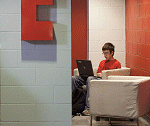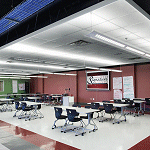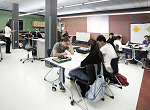Space Craft
- By Jennifer Demski
- 08/01/09
CRAFT Innovative architecture is bringing form
to the function of 21st-century learning.
 IN her first visit with the design team for the new high school she would be presiding
over, Principal Tabitha Branum was blunt about what needed to be
done. "When I met with them for the first time," she says, "I said, 'You tell
me where I can knock down any and all walls. You tell me what's not load bearing,
because I'm gonna knock those walls down.'"
IN her first visit with the design team for the new high school she would be presiding
over, Principal Tabitha Branum was blunt about what needed to be
done. "When I met with them for the first time," she says, "I said, 'You tell
me where I can knock down any and all walls. You tell me what's not load bearing,
because I'm gonna knock those walls down.'"
The mission was to transform what had been a traditional elementary school site
into an academy-style high school, replicating a newfangled school architectural model
that enables 21st-century skills to thrive. Studio-style open spaces that recall the aesthetics
of a corporate loft would replace the right angles and enclosed environment of
the brick-and-mortar classroom. "The entire infrastructure of what was inside the four
walls had to go," Branum says. "We had to be willing to let go of any existing room--
size, dimensions, everything."
The construction of New Tech High at Coppell, in Coppell, TX, would take eight weeks,
completed in time for the 2008-2009 school year and producing an example of how
workplace design principles can be coordinated with
modern educational goals. The campus was built on
the model of New Technology High School in Napa,
CA, the flagship campus for the New Technology
Foundation's network of schools. The foundation, a
nonprofit organization founded in 1999, promotes
project-based learning supported by a 1-to-1 computing
mandate at each of its campuses, which each
house no more than 500 students. Coppell Independent
School District spent a year researching
academy-style schools around the country, in places
such as Arizona, Nevada, California, and Ohio.
"In the end, we kept coming back to the New Tech schools,"
says Branum, former assistant principal of the district's other
high school, Coppell High School. "They truly exemplify the
21st-century skills that we wanted for our students. The New
Tech model was the only one that could actually deliver that."

MOVING PARTS Portable desks allow classrooms at
Columbus Signature Academy to quickly convert from
direct instruction to small-group collaboration.
With their emphasis on transparent, glass-walled classrooms
within which collaborative lessons are carried out not by teacher
and student but facilitator and learner, the New Tech schools
depart sharply from traditional schoolhouses. To prepare for this
shift in educational culture, the foundation recommends that
districts adopting its methodology designate an entirely separate
location at which to build the new school.
"When you separate the students into a new building, you're
able to facilitate this culture much more rapidly and much
more effectively than if you were trying to do it inside an
existing high school, where students are mixing in common
areas with students and teachers who are in a traditional
model," says Shannon Buerk, an education design strategist
with Cambridge Strategic Services, which has consulted on
multiple New Tech projects, including Coppell. "It's hard to
create this real student-driven, collaborative culture inside a
traditional high school."
A decision made by Coppell early on in the campus'
construction created possibilities never available during the
building of the other New Tech sites. The technology had progressed
enough to allow Coppell to meet the 1-to-1 computing
requirement with wireless laptops rather than the plugged-in
desktops the other New Tech schools used. This was a major
step forward, says Kevin Gant, a school development coach for
the New Technology Foundation, because it allowed a basic
element of the group's 21st-century ethos to flourish.
"When you walk into one of the older schools, it has desktop
computers," Gant says. "You get the sense that the class is about
computers, not collaboration. When you walk into Coppell, all
the students have laptops and you see students face-to-face all
the time. You get a sense that collaboration is the most important
thing here."
Without having to worry about creating stations for desktop
computers, Cambridge Strategic Services and its partner, the
SHW Group, an architectural firm that focuses on education,
were free to begin turning the former elementary school into a
modern learning center. The designers worked to create a space
that mimicked a creative professional environment similar to a
New York City loft and would excite and inspire students.
"I knew I wanted transparency," Branum says. "We wanted
lots of glass, where learners could see one another working
from across the hall." Old closets were reshaped into projectplanning
rooms. "If you can imagine a room that has 50
learners in it with eight or nine project teams working, that
can be a lot of noise. It's wonderful to have the flexibility to
send a group of learners into one of the project-planning
rooms, and give them a space where they feel like they can
work and be more productive."
What Do Students Want? Mobility, Comfort
 EDUCATION DESIGN COMPANY SHW Group and its
partner firm, Cambridge Strategic Services,
recently teamed with New Technology High School (pictured) in
Napa, CA, to conduct a student forum on modern classroom design.
Cambridge design strategist Shannon Buerk joined with designers from
SHW and one of its sustainability experts to lead 15 sophomores and
juniors-- all aspiring architects, engineers, and educators with an interest
in sustainability-- through the process of creating a low-cost, portable,
and carbon-neutral learning environment.
EDUCATION DESIGN COMPANY SHW Group and its
partner firm, Cambridge Strategic Services,
recently teamed with New Technology High School (pictured) in
Napa, CA, to conduct a student forum on modern classroom design.
Cambridge design strategist Shannon Buerk joined with designers from
SHW and one of its sustainability experts to lead 15 sophomores and
juniors-- all aspiring architects, engineers, and educators with an interest
in sustainability-- through the process of creating a low-cost, portable,
and carbon-neutral learning environment.
The SHW contingent conducted visualization exercises and brainstorming
sessions to focus the students on the atmosphere and tools necessary for
a successful learning space. "What came out of this process was that the
students felt their personal device-- their computer, their PDA, their iPhone--
was what they considered to be their primary learning tool," Buerk says. "If
they had that personal device, they didn't need anything else. It's you, your
brain, your teacher, your computer, and you're good to go."
This determination guided the students as they conjured up their ideal
learning environment, which prioritized openness and mobility and the flexibility
to use their personal devices in different venues. "They wanted to make
sure that nothing impeded their ability to be mobile, be connected to the
outdoors, and be connected to other people,"
Buerk says, "but they also felt it was important
to have a main space that created a
comfortable, open, inviting, spacious, and
customizable learning environment."
From there, the experts worked with the
students to create designs reflecting these
concerns, with an eye toward constructing
spaces that were high in performance but low in cost. What resulted were
cutting-edge prototypes for 21st-century classrooms. Buerk notes, however,
that just asking students what they want is pretty cutting edge in itself.
"The single most powerful thing that could improve our learning environments
is getting the student voice involved," she says. "Every time we try to
design a building and do strategic planning with a district, we include the
students in the creation process. Who better to know what could work?"

A CLEAN, WELL-LIGHTED PLACE Columbus Signature Academy Principal Mike Reed
says visitors to his campus should not recognize that they’ve entered a high school.
The ceilings were opened up to expose the wiring and air
ducts. "By making the building a little bit unfinished, a little bit
roughed out, it has a more creative, messy feel," Buerk says. "It
looks like learning and creativity happen there." Also, the
designers filled the space with furniture that was comfortable,
adaptable, and, most importantly, didn't look as if it belonged in
a school. Purchased from Ikea, the desks can be moved about
and the chairs are on wheels. Adds Branum, "Ikea was affordable,
comfortable, flexible, very kind of cutting edge, especially
for this generation; they love that modern look."
A Blank Slate
The reverse of the charge given to Coppell architects
to knock down existing structures was handed to the
designers of another New Tech campus, Columbus
Signature Academy in Columbus, IN, who were given an
empty space and told to build anew.
The district chose the abandoned Hoosier Auto Parts
Warehouse in downtown Columbus as the site of the new
campus. It was an unconventional choice that paid off,
says Mike Reed, the school's principal. "The beauty of
the building was that it wasn't chopped up into spaces
already. It was a blank slate. The location made it ideal:
It's centrally located between our two larger high schools
and very close to some post-secondary campuses."
Reed and his faculty members collaborated with Indianapolis-
based CSO Architects to develop the space, with
the same vision that drove Branum at New Tech High at
Coppell. "We wanted it to reflect a 21st-century workspace,"
Reed says. "Guests' first impression should not be that
they've entered a high school."
John Rigsbee, CSO's
lead designer on the
project, used the firm's
own work facility as a
template for the new
campus. "It's very open, very few walls, and has spaces for large- and
small-group work as well as individual work," he says.
Thus, the new school building, which, like Coppell, opened
last year, resembles a corporate office, with a lobby fronted by
a receptionist and outfitted with comfortable furniture, and an
internet bar where visitors can check their e-mail. Past the lobby
are two 1,800-square-foot studios. In each, two teachers lead
50 students in collaborative projects focused on the school's
academic thrust: STEM-- science, technology, engineering, and
math-- learning. The studios are designed to support both traditional
direct instruction, where all 50 students are facing the
teacher as information streams from the front of the room, and
collaborative learning, where students work on their own in
small groups and the teacher's role recedes.
"We were able to accomplish a lot of the flexibility we
needed with furniture," Reed says. "The tables fold quickly--
they're all on wheels. The transition between direct instruction
and small-group collaboration happens very quickly."
Reed also wanted a space that reinforced New Tech's core
values of trust, respect, and responsibility and demonstrated the
principle that the work of students and teachers is public and
should be transparent. Thus, all of the servers and cable trays are
exposed and open. There are no lockers for the students; instead
there are student storage areas where they can leave books and
personal items between classes. Interior windows line the studio
spaces, and the teachers' work areas are open to students.
As happened at the Coppell campus, the decision to use wireless
laptops to complete the 1-to-1 rollout increased flexibility
and mobility throughout the school. "Our tech director pointed
out that if we're emphasizing 21st-century skills, desktops don't
fit that plan," Reed says. "These days, people in the workplace
have laptops or handheld devices they take with them wherever
they go. Our kids can move into any part of the studio. They can
move their group into a multipurpose room; they can move into
the hallway and have a mini-workshop. The wireless environment
creates a true 21st-century learning center."
And it's the environment, not the technology, Buerk from
Cambridge Strategic Services explains, that allows the instructional
goals to flourish and an educational culture to develop.
"The name 'New Tech' sometimes gets in the way of what New
Tech is all about," she says. "People think of it automatically as
a tech school. It's really all about the culture, the collaboration,
the soft skills that students are learning through the projectbased-
learning methodology." Buerk says the architect acts at the
behest of that methodology. "Our ultimate goal is that the instruction
drive the design, and that the design inspire learning."
::WEBEXTRAS ::
If you would like more information on modern school design, visit our website at www.thejournal.com.
Enter the keywords school modernization.